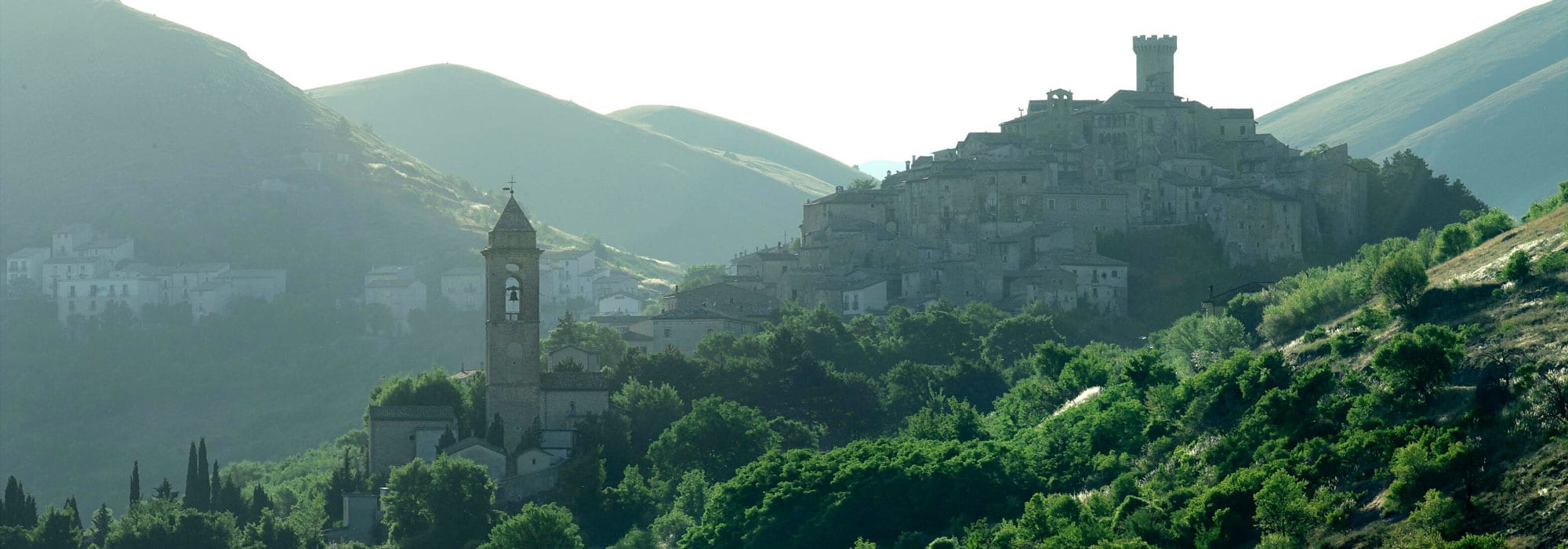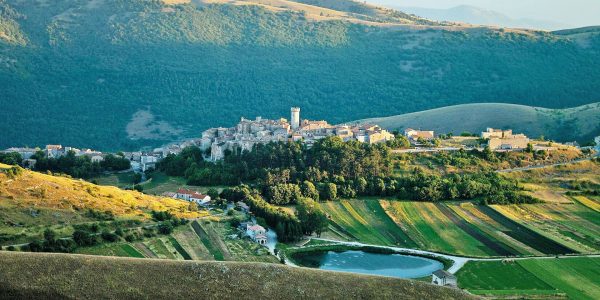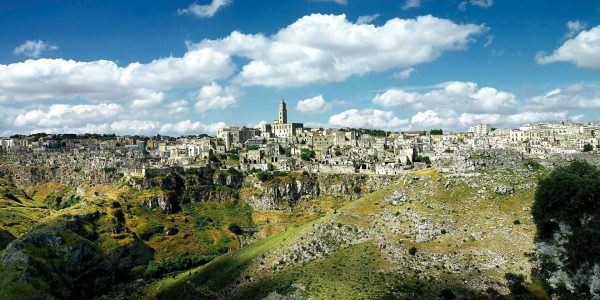The first thing you will experience when walking through Santo Stefano di Sessanio is that it feels, quite literally, frozen in time. Just a two-hour drive from Rome, its beauty is rustic and unadulterated. Perched on the highest part of the Apennine Mountain range in Abruzzo, you see the rolling hills of Campo Imperatore as far as the eye can see. Locals often refer to these mountains as Little Tibet. This raw geographic magnificence, which once helped Santo Stefano become a strategic town for the Medici family to rule because of the prolific sheep herding, was essential for the booming local wool trade that would then be worked in Florence and sold throughout the world.
Today though, it’s much quieter. The town remains nearly untouched, which begs one to imagine the town when it was booming and buzzing with sheep and shepherds, bargaining for the price of wool in the square. Women hovering over massive boiling pots of water, the fires blackening the walls, to boil and clean the wool to send to Florence. Like many villages in the Italian Mezzogiorno or southern regions, Santo Stefano was once thriving and prosperous and built on agriculture.
But in time, things changed. Historically, from the post-war era up until today, the southern Italian regions were not prized for their development projects. In response to the significant depopulation of the Italian towns of Italy, in 1950, the government founded the “Cassa del Mezzogiorno,” which translates to the Funds for Southern Italy, which financed infrastructure that was much too expansive for the actual needs of the locals that remained. This industrialization has had a high cost of implementation, management, and finally, in some cases, even dismantling some of Italy’s ancient villages.
From a private business standpoint, cement, or this new wave of cheaper, apparently more practical construction, seemed like an intelligent development model for a business. However, this led to the invasive urbanization of the post world war era of the peninsula, erasing some of the ancient histories that helped build the country. Italy has one of the highest indexes of houses per resident in all of Europe and yet one of the lowest birth rates in the world. All of this has brought to an almost vanishing of the artificial landscape consisting of centuries-old villages.
A 2016 report shows nearly 2,500 rural Italian villages are severely depopulated, many partially and others wholly abandoned. In part, this is why the boom of the 1$ home trend thrived in recent years, an attempt to repopulate the thousands of rural and empty towns of Italy. https://www.legambiente.it/comunicati-stampa/premio-voler-bene-allitalia-le-storie-dei-piccoli-comuni-nellitalia-segnata-dal-covid-19/
These Italian villages, often in the center and south of Italy, have largely lived through this fate due to the intersection of urbanization of cities, mass emigration to these new meccas post WWII, natural disasters, and increased poverty. Opportunities, at the time, were thought to be only in these big industrialized centers and not in our forefathers’ rural, agriculturally driven towns. This migrational shift was the catalyst for empty houses, schools, and shops and leaving fields uncultivated, which we see today.
But until the relationship between the historic village and its surroundings is not considered “cultural patrimony” and subsequently passed on to the next generation, we will continue to see administration after administration brings new constructions unnecessary to these semi-abandoned villages.
From their inception, the cultural and economic identity of these villages was intricately woven around the agriculture of the countryside, the farmers, merchants, artisans, and shepherds all working together to survive but ultimately weaving a unique identity inspired by what was available. This local reality that once was an integral part of the identity of much of Italy has been forgotten. However, the strength of these ancient localities, frozen in time and often abandoned, now leaves an opportunity to hone the broader Italian cultural identity leaving space for a cultural paradigm shift.
These small towns constitute the soul and spirit of Italian culture. Often they are unknown to foreigners, perhaps not even experienced by Italians, and offer an opportunity to discover lesser-known artisanal traditions, local produce, and products that never even left the local area.
The irony and wealth of these villages are that they have been preserved for the very reason that condemned them: economic privation and desertion.
You may already know the story of Daniele Kihlgren. This man found himself serendipitously and accidentally in the Apennine Mountain range while getting lost in the town of Santo Stefano on his motorcycle. He was intrigued by the quiet little town with a few families still residing there for generations. Many of the buildings are sitting, slightly crumbling and uninhabited. The contemporary owners had left the town but inherited properties from their families. They weren’t interested in keeping them; many of the inheritors were in big cities or overseas. Having left themselves or a few generations earlier seeking opportunity elsewhere. It’s a typical story.
Kihlgren wanted to do more. He was often called crazy for spending so much of his own money not to rebuild some of the structures of Santo Stefano to modern cement-covered glamour but to restore the buildings to their medieval prime. He kept the soot and smoke on the walls, a remnant of when the town thrived while boiling wool. It is part of its identity, it shows the past and what built this town. Kihlgren had a vision.
Kihlgren worked with an anthropologist, Nunzia Taraschi, who painstakingly went through historical museum archives to understand what the blankets looked like, what soaps the local women would use, and how people lived and ate in the town. The vision has created a scattered hotel that uses local artisans who looms the blankets on the beds, make the candles using beeswax as would be done during the medieval era, and women that cure the meats and preserve the vegetables in the way that was once done.
The purpose for all of this is to build as it was once built, together with the community.
In recent years, there have been many debated formulas for how to redefine abandoned villages as functioning and economically thriving models. A prerequisite must be considered a priority to any revitalization-preservation policy, specifically for nearly or fully abandoned villages. The integral protection of these locals’ historical and landscape heritage helps people understand the power these villages have to act as sustainable economic and business models by using the unique resources that Italy already has.
These historic villages can represent a new frontier for today’s renewed tourism. A type of tourism that is increasingly in demand by an audience that is attentive to local identities and interested in genuine and authentic. Perhaps our country, more than others, specifically the Italian south, which has experienced an important history and a dramatic depopulation, could trigger a new type of tourist re-destination to these lesser-known nearly abandoned villages.
The notion of building apprenticeship programs to educate younger generations in skills that can help keep the traditional products alive and using local products could be how we move toward a new type of sustainable tourism.
This is a series to understand another side of Italian identity better. What was always the historic backbone of Italy built by the fortitude of people from the rural villages that were once the motor of Italy. The years of these villages being abandoned and preserved properly could resolve the question of sustainable cultural patrimony for the future.
-Valentina Di Donato



